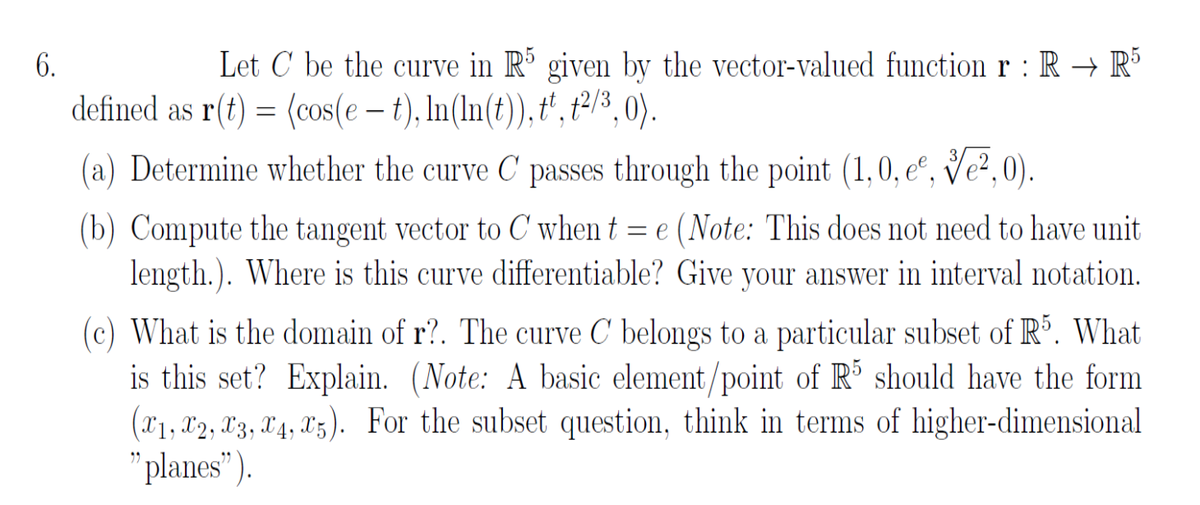6. Let C be the curve in R´ given by the vector-valued function r : R → R defined as r(t) = (cos(e – t), In(ln(t)), t', t2/3,0). (a) Determine whether the curve C passes through the point (1,0, eº, Ve?, 0). (b) Compute the tangent vector to C when t length.). Where is this curve differentiable? Give your answer in interval notation. = e (Note: This does not need to have unit (c) What is the domain of r?. The curve C belongs to a particular subset of Rº. What is this set? Explain. (Note: A basic element/point of R³ should have the form (*1, X2, T3, C4, Tz). For the subset question, think in terms of higher-dimensional "planes").
6. Let C be the curve in R´ given by the vector-valued function r : R → R defined as r(t) = (cos(e – t), In(ln(t)), t', t2/3,0). (a) Determine whether the curve C passes through the point (1,0, eº, Ve?, 0). (b) Compute the tangent vector to C when t length.). Where is this curve differentiable? Give your answer in interval notation. = e (Note: This does not need to have unit (c) What is the domain of r?. The curve C belongs to a particular subset of Rº. What is this set? Explain. (Note: A basic element/point of R³ should have the form (*1, X2, T3, C4, Tz). For the subset question, think in terms of higher-dimensional "planes").
Algebra & Trigonometry with Analytic Geometry
13th Edition
ISBN:9781133382119
Author:Swokowski
Publisher:Swokowski
Chapter11: Topics From Analytic Geometry
Section: Chapter Questions
Problem 18T
Related questions
Topic Video
Question
100%
Please give detail as much as possible.

Transcribed Image Text:6.
Let C be the curve in R´ given by the vector-valued function r : R → R³
defined as r(t) = (cos(e – t), In(In(t)), t', t213,0).
(a) Determine whether the curve C passes through the point (1,0, eº, Ve²,0).
(b) Compute the tangent vector to C when t = e (Note: This does not need to have unit
length.). Where is this curve differentiable? Give your answer in interval notation.
(c) What is the domain of r?. The curve C' belongs to a particular subset of R°. What
is this set? Explain. (Note: A basic element/point of R should have the form
(X'1, X2, X3, X4, X5). For the subset question, think in terms of higher-dimensional
"planes").
Expert Solution
This question has been solved!
Explore an expertly crafted, step-by-step solution for a thorough understanding of key concepts.
This is a popular solution!
Trending now
This is a popular solution!
Step by step
Solved in 3 steps with 3 images

Knowledge Booster
Learn more about
Need a deep-dive on the concept behind this application? Look no further. Learn more about this topic, advanced-math and related others by exploring similar questions and additional content below.Recommended textbooks for you

Algebra & Trigonometry with Analytic Geometry
Algebra
ISBN:
9781133382119
Author:
Swokowski
Publisher:
Cengage

Algebra & Trigonometry with Analytic Geometry
Algebra
ISBN:
9781133382119
Author:
Swokowski
Publisher:
Cengage